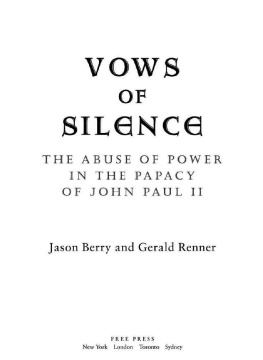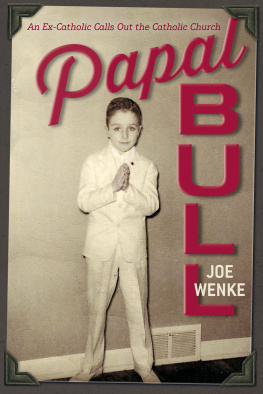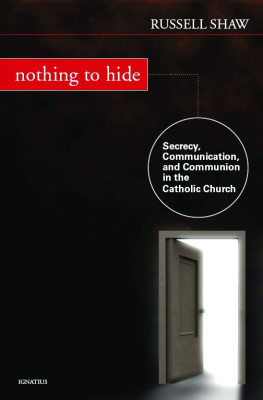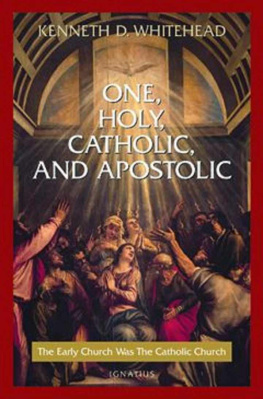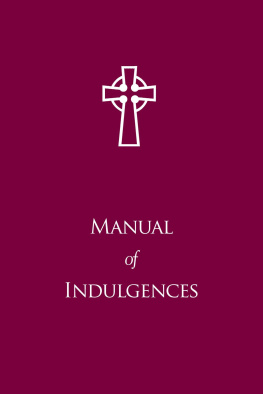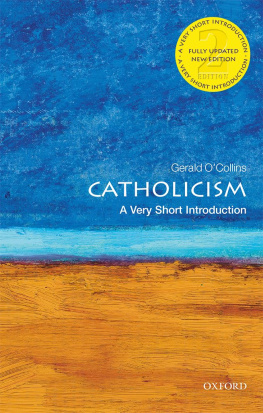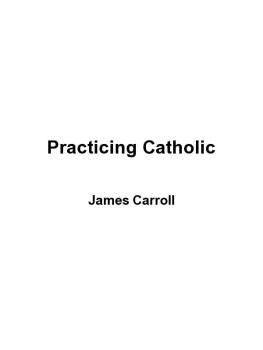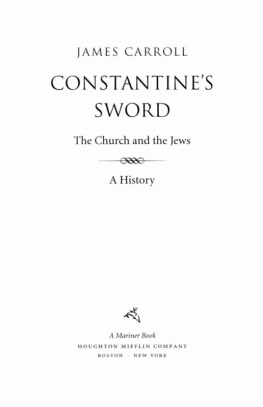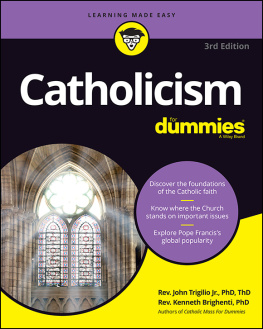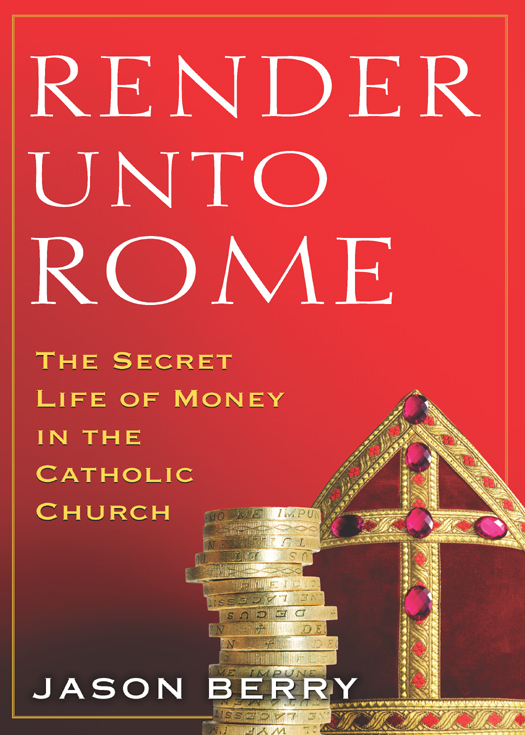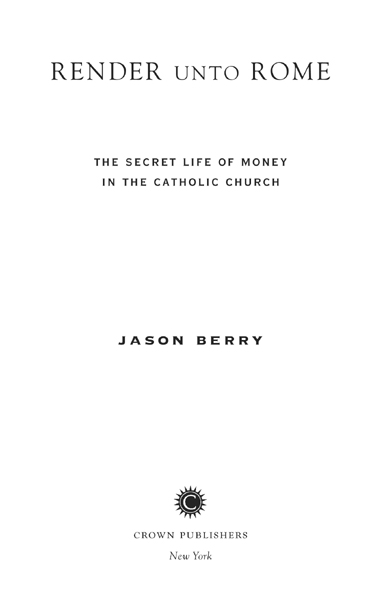ALSO BY JASON BERRY
PLAY
Earl Long in Purgatory
FICTION
Last of the Red Hot Poppas
NONFICTION
Up from the Cradle of Jazz:
New Orleans Music Since World War II
(with Jonathan Foose and Tad Jones)
Vows of Silence: The Abuse of Power in the Papacy of
John Paul II (with Gerald Renner)
Louisiana Faces: Images of a Renaissance
(with photographs by Philip Gould)
The Spirit of Black Hawk: A Mystery of Africans and Indians
Lead Us Not into Temptation: Catholic Priests and the
Sexual Abuse of Children
Amazing Grace: With Charles Evers in Mississippi
Copyright 2011 by Jason Berry
All rights reserved.
Published in the United States by Crown Publishers, an imprint of the Crown Publishing Group, a division of Random House, Inc., New York.
www.crownpublishing.com
CROWN and the Crown colophon are registered trademarks of Random House, Inc.
Library of Congress Cataloging-in-Publication Data Berry, Jason.
Render unto Rome: the secret life of money in the Catholic Church / Jason Berry.1st ed.
p. cm.
1. Catholic ChurchFinance. I. Title.
BX1950.B47 2011
262.020681dc22 2010051105
eISBN: 978-0-385-53133-7
Jacket design by David Tran
Jacket photograph: Istock.com
v3.1
In memoriam
Ariel Laforet Berry,
child of my heart
Gerald Renner,
colleague and friend
I am an old policeman guarding the gold reserves. If you tell an old policeman that the laws are going to change, he will realize that he is an old policeman, and he will do everything that he can to prevent them from changing Once the new laws have become the Churchs treasure, an enrichment of her gold reserves, there is still only one principle: loyalty in the Churchs service. But this service means loyalty to her lawslike a blind man. Like the blind man that I am.
Cardinal Alfredo Ottaviani, Prefect of the Holy Office, to Mario von Galli in The Council and the Future (1966)
CONTENTS
P ROLOGUE
PRINCES OF THE REALM
The church stood at the bottom of Bunker Hill in Charlestown, one of the citys oldest neighborhoods. Like much of Greater Boston, Charlestown was no longer hard-shell Irish. The wooden triple-deckers that housed large working families in decades past had become pearls for gentrification in 2004, despite the outlying streets that bore the scars of a drug economy.
The social mosaic at St. Catherine of Siena parish delighted Rose Mary Piper. She was in the winter of life, with four children grown and grandchildren nearing adulthood. The range of people in the pews, so different from that of the predominantly white parishes she had known, touched her identity as one soul united with a greater body of believers. From the housing projects along Mystic River came Puerto Ricans and people from the Dominican Republic to Sunday Mass, with their Spanish songs and bilingual bulletins, worshipping alongside people with Irish roots and then more cosmopolitan Bostonians like her son-in-law, Peter Borr, who lived in a nearby condo.
Rosie Piper knew the Latino women had it tough, like her ancestors who got off the ships from Ireland and made it in Staten Island, New York. To live is to change. When her husband was diagnosed with dementia, Rosie oversaw the selling of their home in Hilton Head, South Carolina. For most of their long marriage, Bill Pipers career as a chemical engineer with DuPont had anchored them in Delaware. Rosie had enjoyed their time in the South. But with the realization that she alone could not manage his needs, she decided on the Boston area, where their two daughters had settled. Mary Beth, the rebellious one, no longer went to church; but her husband, Peter, attended Mass with Rosie.
Every Sunday, Rose Mary Piper put a $10 check in the collection basket, a practice ingrained with time. Peter gave cash. The worldview Peter Borr carried from his navy years turned on just authority. You went to church, prayed for those you loved, asked forgiveness for your sins, and donated money because it was the right thing to do. Until the scandal rocked Boston neither of them thought much about church finances, how a given dollar broke downwhat percentage went to parish costs, what part for the parochial school and to help the poor; how much to the bishop, how much to Rome. You gave money and let the priest and bishop handle it. The Catholic Church was holy, true, apostolic, and wealthy enough to help many of those truly in need.
The revolution in Peter Borrss life began in 2004, when the Boston archdiocese imposed a sweeping closure plan on parish churches some months after a legal settlement with 552 clergy abuse victims. Cardinal Law covered up for child molesters, brooded Rosie Piper, and now they sell churches! Peter Borr, who led a comfortable life, was also offended, but he soon acquired a cold curiosity about the money. As Borr would learn, many American Catholics were riled about just stewardship: how bishops manage the finances. Huge legal settlements caused by bishops who recycled pedophiles, churches closed against the peoples will, continuing reports of priests or lay staffers who stole parish fundsall fed a deep sense of betrayal. In 2010 an upsurge of clergy abuse cases showed bad decisions by Cardinal Joseph Ratzinger long before he became pope. As Benedict XVI met with victims and apologized, he nevertheless seemed detached, in a surreal way, from the obvious need for structural reform.
Since the harrowing struggle of Benedict XV during World War I, the role of the pope has enlarged, dramatically, from that of a supreme religious leader to that of an international advocate for peace. Following the Great War, a succession of popes emerged as moral statesmen on the global stage, slowly distancing themselves from a history of anti-Semitic views within the church and calling for dialogue and diplomacy over armed conflict,
His successor, Paul VI, made a point of often saying, If you want peace, work for justice. though he mentioned no pope by name.
In his last dozen years, John Paul damaged his own legacy on human rights by failing to appropriately acknowledge the victims of clergy child abusers and to act forcefully on the clear signs of a criminal sexual underground in clerical culture. Benedict XVI inherited a Vatican tribunal system averse to punishing bishops who were sex offenders or complicit in concealing them. By failing to show resolve as a ruler and bring the worst bishops to justice, Benedict has invited scrutiny of the Vaticans legal system, such as it is. Vatican offices have largely rubber-stamped bishops financial decisions. How that Vatican legal system functions is the central theme of this book.
Render unto Rome follows a series of property and financial decisions that link certain American bishops and Vatican officials; the book further examines how Father Marcial Maciel, the greatest fund-raiser of the modern church, became its greatest criminal. In following these narrative lines I have taken a deep look at the handling of church assets in Boston, Cleveland, and Los Angeles, interlaced with events from other dioceses and a recurrent focus on the Congregation for the Clergy, the Vatican office that monitors how bishops sell property. A key official in Clergy recently assisted a profiteering scheme on the sale of U.S. churches. A central figure in that scheme, Cardinal Angelo Sodano, was Vatican secretary of state for fourteen years under John Paul and slightly more than a year under Benedict. Sodano was also a tireless supporter of Father Maciel. The cardinal refused to be interviewed; however, FBI findings on the business dealings of his nephew were of great help, along with other sources, as I put a viewfinder on Sodano and his machinations.


